Jongpil Lee
Musical Word Embedding for Music Tagging and Retrieval
Apr 23, 2024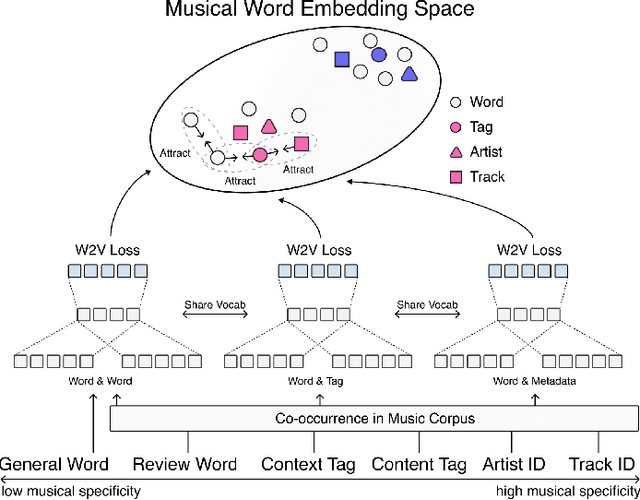


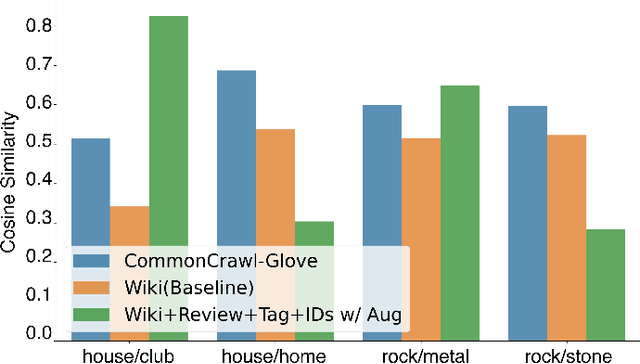
Abstract:Word embedding has become an essential means for text-based information retrieval. Typically, word embeddings are learned from large quantities of general and unstructured text data. However, in the domain of music, the word embedding may have difficulty understanding musical contexts or recognizing music-related entities like artists and tracks. To address this issue, we propose a new approach called Musical Word Embedding (MWE), which involves learning from various types of texts, including both everyday and music-related vocabulary. We integrate MWE into an audio-word joint representation framework for tagging and retrieving music, using words like tag, artist, and track that have different levels of musical specificity. Our experiments show that using a more specific musical word like track results in better retrieval performance, while using a less specific term like tag leads to better tagging performance. To balance this compromise, we suggest multi-prototype training that uses words with different levels of musical specificity jointly. We evaluate both word embedding and audio-word joint embedding on four tasks (tag rank prediction, music tagging, query-by-tag, and query-by-track) across two datasets (Million Song Dataset and MTG-Jamendo). Our findings show that the suggested MWE is more efficient and robust than the conventional word embedding.
LP-MusicCaps: LLM-Based Pseudo Music Captioning
Jul 31, 2023Abstract:Automatic music captioning, which generates natural language descriptions for given music tracks, holds significant potential for enhancing the understanding and organization of large volumes of musical data. Despite its importance, researchers face challenges due to the costly and time-consuming collection process of existing music-language datasets, which are limited in size. To address this data scarcity issue, we propose the use of large language models (LLMs) to artificially generate the description sentences from large-scale tag datasets. This results in approximately 2.2M captions paired with 0.5M audio clips. We term it Large Language Model based Pseudo music caption dataset, shortly, LP-MusicCaps. We conduct a systemic evaluation of the large-scale music captioning dataset with various quantitative evaluation metrics used in the field of natural language processing as well as human evaluation. In addition, we trained a transformer-based music captioning model with the dataset and evaluated it under zero-shot and transfer-learning settings. The results demonstrate that our proposed approach outperforms the supervised baseline model.
Pseudo-Label Transfer from Frame-Level to Note-Level in a Teacher-Student Framework for Singing Transcription from Polyphonic Music
Mar 30, 2022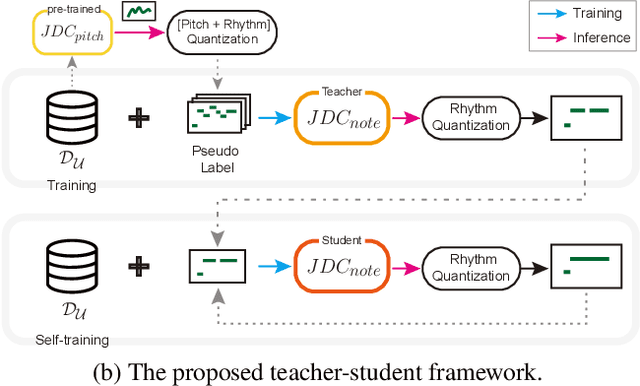
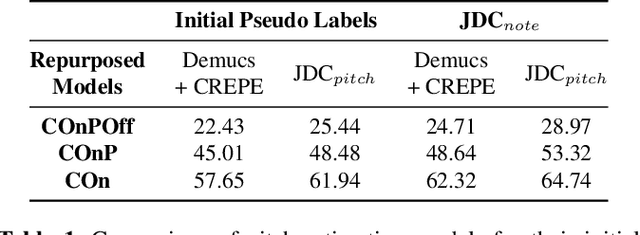
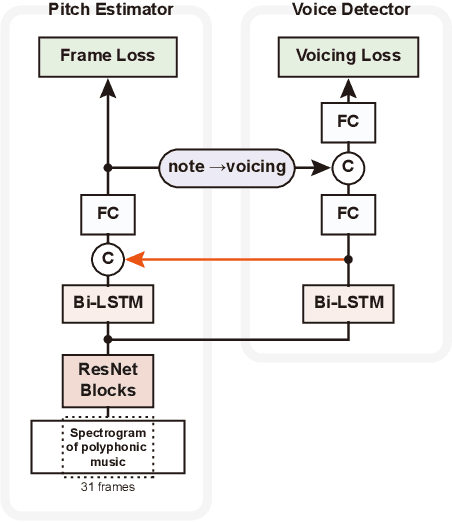
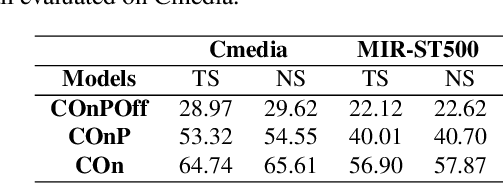
Abstract:Lack of large-scale note-level labeled data is the major obstacle to singing transcription from polyphonic music. We address the issue by using pseudo labels from vocal pitch estimation models given unlabeled data. The proposed method first converts the frame-level pseudo labels to note-level through pitch and rhythm quantization steps. Then, it further improves the label quality through self-training in a teacher-student framework. To validate the method, we conduct various experiment settings by investigating two vocal pitch estimation models as pseudo-label generators, two setups of teacher-student frameworks, and the number of iterations in self-training. The results show that the proposed method can effectively leverage large-scale unlabeled audio data and self-training with the noisy student model helps to improve performance. Finally, we show that the model trained with only unlabeled data has comparable performance to previous works and the model trained with additional labeled data achieves higher accuracy than the model trained with only labeled data.
Disentangled Multidimensional Metric Learning for Music Similarity
Aug 12, 2020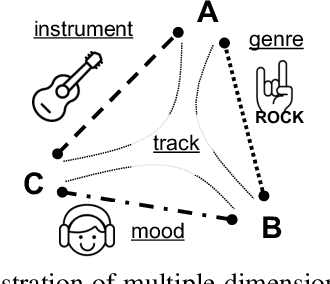

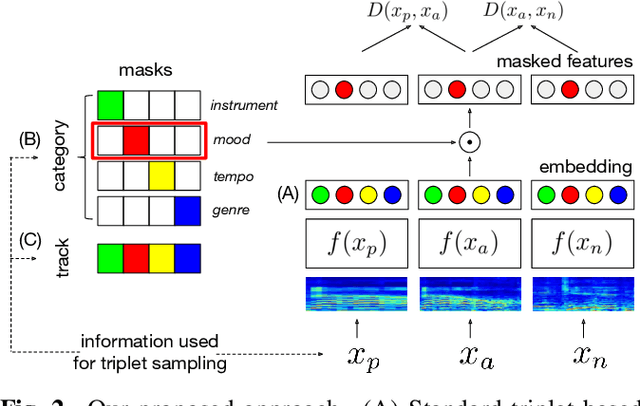
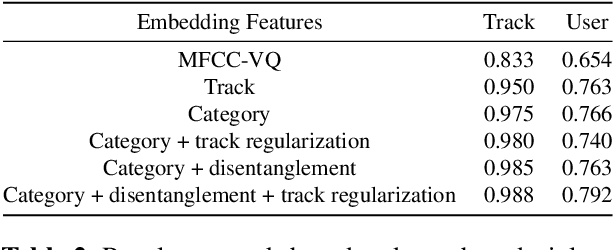
Abstract:Music similarity search is useful for a variety of creative tasks such as replacing one music recording with another recording with a similar "feel", a common task in video editing. For this task, it is typically necessary to define a similarity metric to compare one recording to another. Music similarity, however, is hard to define and depends on multiple simultaneous notions of similarity (i.e. genre, mood, instrument, tempo). While prior work ignore this issue, we embrace this idea and introduce the concept of multidimensional similarity and unify both global and specialized similarity metrics into a single, semantically disentangled multidimensional similarity metric. To do so, we adapt a variant of deep metric learning called conditional similarity networks to the audio domain and extend it using track-based information to control the specificity of our model. We evaluate our method and show that our single, multidimensional model outperforms both specialized similarity spaces and alternative baselines. We also run a user-study and show that our approach is favored by human annotators as well.
Metric Learning vs Classification for Disentangled Music Representation Learning
Aug 12, 2020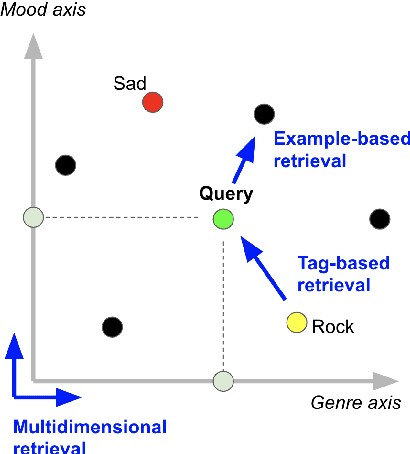


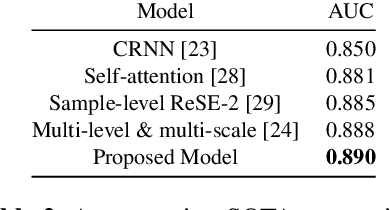
Abstract:Deep representation learning offers a powerful paradigm for mapping input data onto an organized embedding space and is useful for many music information retrieval tasks. Two central methods for representation learning include deep metric learning and classification, both having the same goal of learning a representation that can generalize well across tasks. Along with generalization, the emerging concept of disentangled representations is also of great interest, where multiple semantic concepts (e.g., genre, mood, instrumentation) are learned jointly but remain separable in the learned representation space. In this paper we present a single representation learning framework that elucidates the relationship between metric learning, classification, and disentanglement in a holistic manner. For this, we (1) outline past work on the relationship between metric learning and classification, (2) extend this relationship to multi-label data by exploring three different learning approaches and their disentangled versions, and (3) evaluate all models on four tasks (training time, similarity retrieval, auto-tagging, and triplet prediction). We find that classification-based models are generally advantageous for training time, similarity retrieval, and auto-tagging, while deep metric learning exhibits better performance for triplet-prediction. Finally, we show that our proposed approach yields state-of-the-art results for music auto-tagging.
Musical Word Embedding: Bridging the Gap between Listening Contexts and Music
Jul 23, 2020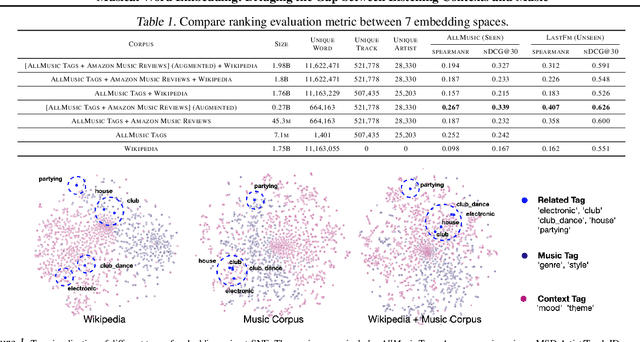
Abstract:Word embedding pioneered by Mikolov et al. is a staple technique for word representations in natural language processing (NLP) research which has also found popularity in music information retrieval tasks. Depending on the type of text data for word embedding, however, vocabulary size and the degree of musical pertinence can significantly vary. In this work, we (1) train the distributed representation of words using combinations of both general text data and music-specific data and (2) evaluate the system in terms of how they associate listening contexts with musical compositions.
Zero-shot Learning for Audio-based Music Classification and Tagging
Jul 05, 2019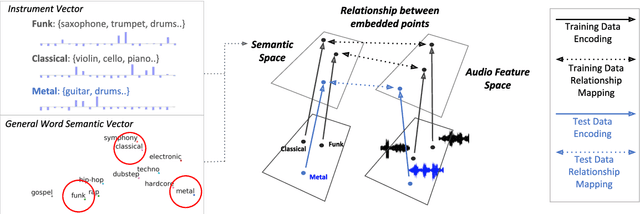

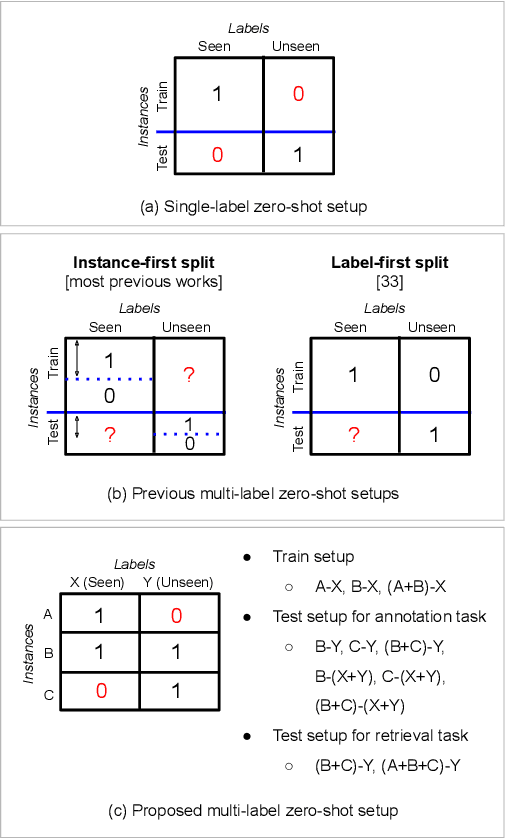
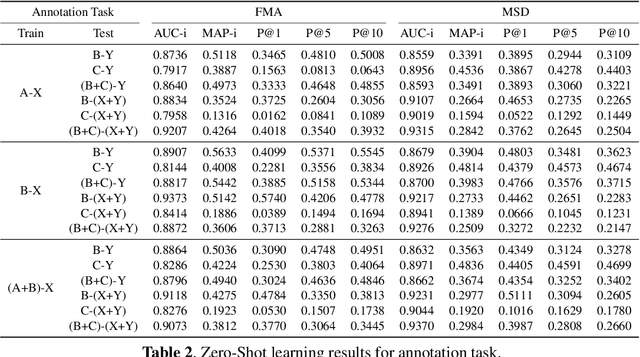
Abstract:Audio-based music classification and tagging is typically based on categorical supervised learning with a fixed set of labels. This intrinsically cannot handle unseen labels such as newly added music genres or semantic words that users arbitrarily choose for music retrieval. Zero-shot learning can address this problem by leveraging an additional semantic space of labels where side information about the labels is used to unveil the relationship between each other. In this work, we investigate the zero-shot learning in the music domain and organize two different setups of side information. One is using human-labeled attribute information based on Free Music Archive and OpenMIC-2018 datasets. The other is using general word semantic information based on Million Song Dataset and Last.fm tag annotations. Considering a music track is usually multi-labeled in music classification and tagging datasets, we also propose a data split scheme and associated evaluation settings for the multi-label zero-shot learning. Finally, we report experimental results and discuss the effectiveness and new possibilities of zero-shot learning in the music domain.
Zero-shot Learning and Knowledge Transfer in Music Classification and Tagging
Jun 20, 2019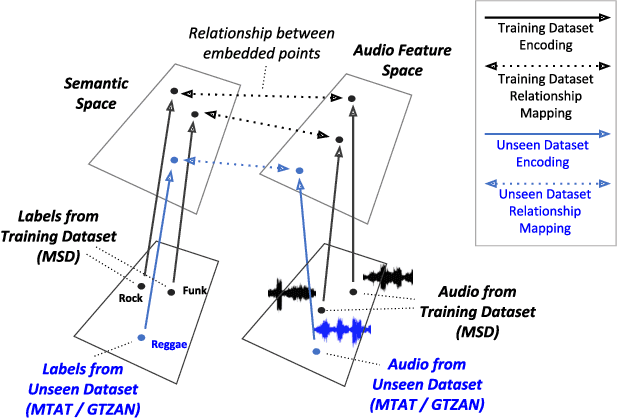

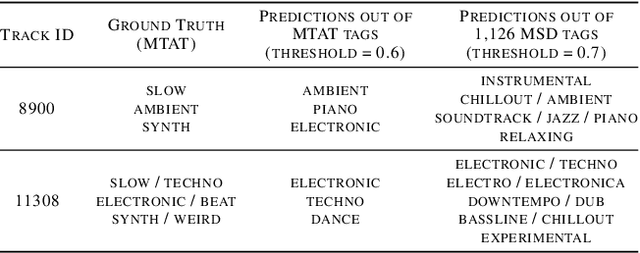
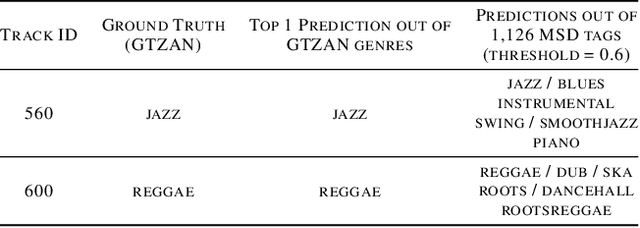
Abstract:Music classification and tagging is conducted through categorical supervised learning with a fixed set of labels. In principle, this cannot make predictions on unseen labels. Zero-shot learning is an approach to solve the problem by using side information about the semantic labels. We recently investigated this concept of zero-shot learning in music classification and tagging task by projecting both audio and label space on a single semantic space. In this work, we extend the work to verify the generalization ability of zero-shot learning model by conducting knowledge transfer to different music corpora.
Deep Content-User Embedding Model for Music Recommendation
Jul 18, 2018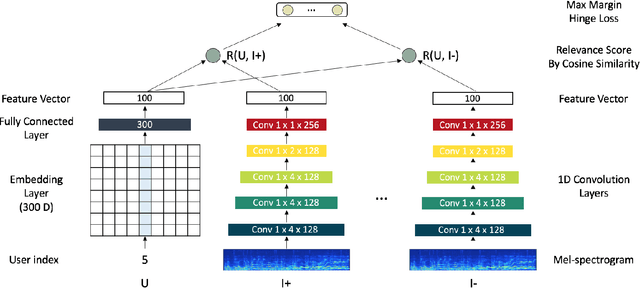


Abstract:Recently deep learning based recommendation systems have been actively explored to solve the cold-start problem using a hybrid approach. However, the majority of previous studies proposed a hybrid model where collaborative filtering and content-based filtering modules are independently trained. The end-to-end approach that takes different modality data as input and jointly trains the model can provide better optimization but it has not been fully explored yet. In this work, we propose deep content-user embedding model, a simple and intuitive architecture that combines the user-item interaction and music audio content. We evaluate the model on music recommendation and music auto-tagging tasks. The results show that the proposed model significantly outperforms the previous work. We also discuss various directions to improve the proposed model further.
Sample-level CNN Architectures for Music Auto-tagging Using Raw Waveforms
Feb 14, 2018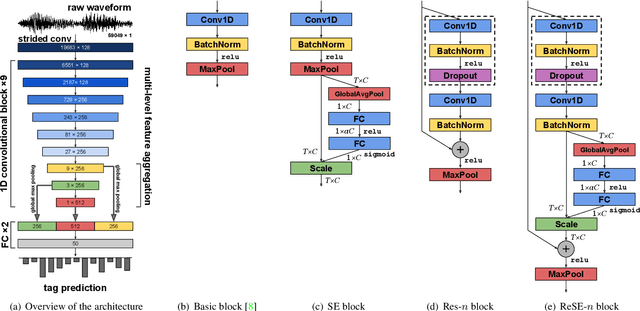
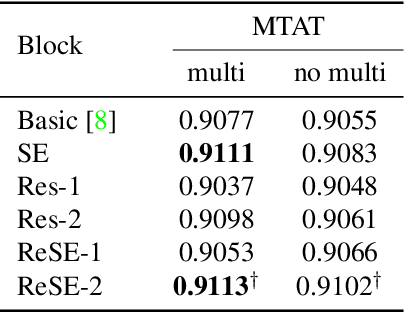
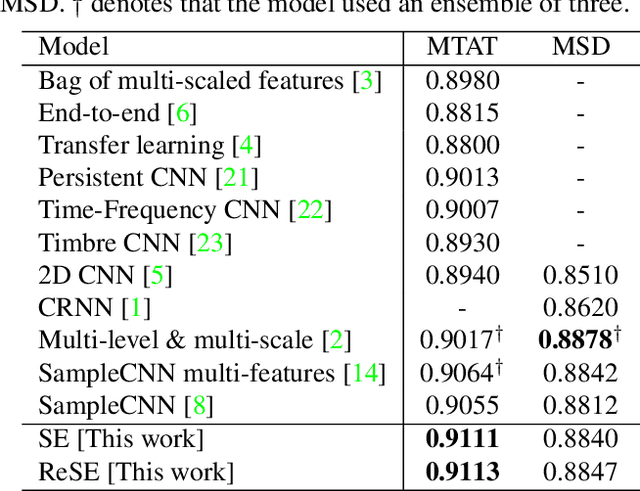
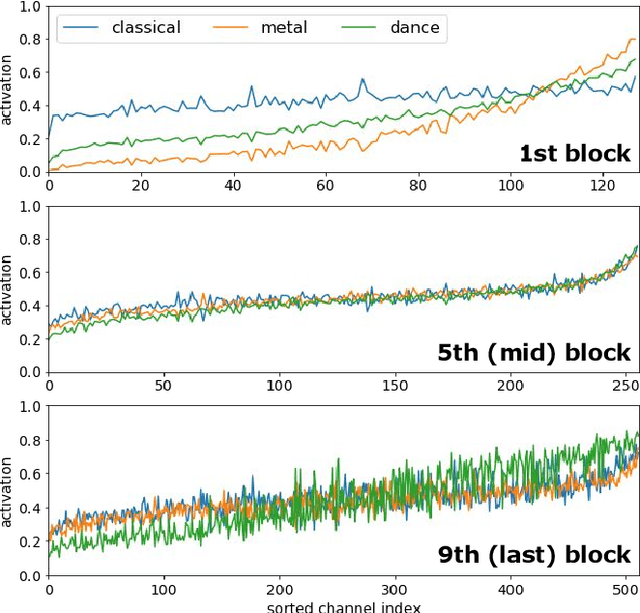
Abstract:Recent work has shown that the end-to-end approach using convolutional neural network (CNN) is effective in various types of machine learning tasks. For audio signals, the approach takes raw waveforms as input using an 1-D convolution layer. In this paper, we improve the 1-D CNN architecture for music auto-tagging by adopting building blocks from state-of-the-art image classification models, ResNets and SENets, and adding multi-level feature aggregation to it. We compare different combinations of the modules in building CNN architectures. The results show that they achieve significant improvements over previous state-of-the-art models on the MagnaTagATune dataset and comparable results on Million Song Dataset. Furthermore, we analyze and visualize our model to show how the 1-D CNN operates.
 Add to Chrome
Add to Chrome Add to Firefox
Add to Firefox Add to Edge
Add to Edge